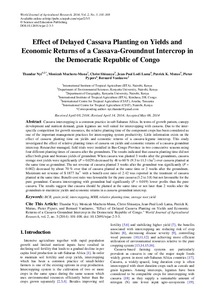| dc.contributor.author | Nyi, T. |
| dc.contributor.author | Mucheru-Muna, M. |
| dc.contributor.author | Shisanya, C. |
| dc.contributor.author | Lodi-lama, J-P. |
| dc.contributor.author | Mutuo, P. |
| dc.contributor.author | Pypers, Pieter |
| dc.contributor.author | Vanlauwe, Bernard |
| dc.date.accessioned | 2019-12-04T11:03:23Z |
| dc.date.available | 2019-12-04T11:03:23Z |
| dc.date.issued | 2014 |
| dc.identifier.citation | Nyi, T., Mucheru-Muna, M., Shisanya, C., Lodi-lama, J-P., Mutuo, P., Pypers, P. & Vanlauwe, B. (2014). Effect of delayed cassava planting on yields and economic returns of a cassava-groundnut intercrop in the Democratic Republic of Congo. World Journal of Agricultural Research, 2(3), 101-108. |
| dc.identifier.issn | 2333-0643 |
| dc.identifier.uri | https://hdl.handle.net/20.500.12478/1030 |
| dc.description.abstract | Cassava intercropping is a common practice in sub-Saharan Africa. In terms of growth pattern, canopy development and nutrient demand, grain legumes are well suited for intercropping with cassava. Due to the inter-specific competition for growth resources, the relative planting time of the component crops has been considered as one of the important management practices for intercropping system productivity. Little information exists on the effect of cassava planting time on yields and economic returns of a cassava-legume intercrop. This study investigated the effect of relative planting times of cassava on yields and economic returns of a cassava-groundnut intercrop. Researcher-managed, field trials were installed in Bas-Congo Province in two consecutive seasons using four different planting times of cassava after the groundnuts. The results indicated that cassava planting time did not affect both grain and biomass yields of groundnut. When cassava was planted 3 weeks after the groundnuts, cassava storage root yields were significantly (P = 0.029) decreased by 48 to 60 % (9.3 to 11.3 t ha-1) over cassava planted at the same time as groundnut. The net revenue of cassava planted 3 weeks after the groundnut was significantly (P = 0.002) decreased by about 70 % over that of cassava planted at the same time or 2 weeks after the groundnuts. Maximum net revenue of $ 1877 ha-1 with a benefit-cost ratio of 2.42 was reported in the treatment of cassava planted at the same time. Benefit-cost ratio was favourable for the pure cassava (3.2 to 3.8) but not favourable for the pure groundnut. Cassava intercropping with groundnut had significantly (P = 0.019) lower profits than the pure cassava. The results suggest that cassava should be planted at the same time or not later than 2 weeks after the groundnuts to maximize yields and economic returns in a cassava-groundnut intercrop. |
| dc.format.extent | 101-108 |
| dc.language.iso | en |
| dc.subject | Grain Crop |
| dc.subject | Intercropping |
| dc.subject | Cassava |
| dc.title | Effect of delayed cassava planting on yields and economic returns of a cassavagroundnut intercrop in the Democratic Republic of Congo |
| dc.type | Journal Article |
| dc.description.version | Peer Review |
| cg.contributor.crp | Roots, Tubers and Bananas |
| cg.contributor.affiliation | International Institute of Tropical Agriculture |
| cg.contributor.affiliation | Kenyatta University |
| cg.contributor.affiliation | International Center for Tropical Agriculture |
| cg.coverage.region | Africa South Of Sahara |
| cg.coverage.country | Congo, Dr |
| cg.authorship.types | CGIAR and developing country institute |
| cg.iitasubject | Cassava |
| cg.journal | World Journal of Agricultural Research |
| cg.howpublished | Formally Published |
| cg.accessibilitystatus | Limited Access |
| local.dspaceid | 77959 |
| cg.identifier.doi | https://dx.doi.org/10.12691/wjar-2-3-3 |

